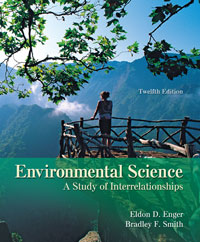 
Environmental Science (Enger) 12th EditionFeature Summary
Feature: Environmental science often seems to focus on the negative, since one of the outcomes of any analysis of an environmental situation is to highlight problems and point out where change is needed.
However, we often overlook the many positive actions of individuals and organizations. Therefore, in this edition there are three new features that call attention to the positive.
• Going Green case studies describe actions that are having a positive environmental impact. Some of these actions are by governments, some are by corporations, and some are individual efforts. These case studies are identified by the “Going Green” icon.
• Campus Sustainability Initiatives highlight some of the many actions of students and the colleges and Universities they attend that are making a positive environmental impact.
• Thinking Green is an end-of-chapter feature that asks students to consider making changes that will have a positive environmental impact
Feature: The concept of interrelatedness is a core concept in environmental science. Although this concept can be illustrated in many ways, in this edition we have chosen to use water as a theme. In every chapter appears a water-themed case study, identified by the “water theme” icon. Sometimes the topic of water is also addressed as a heading in the text.
Feature: Every chapter has new Going Green and water-themed case studies and a Campus Sustainability Initiative box. In addition many chapters have other significant changes. These are highlighted below. Chapter 1 Environmental Interrelationships has a new section entitled Interrelatedness is a Core Concept which uses as a theme John Muir’s statement “Tug on anything at all and you'll find it connected to everything else in the universe.” It then highlights the changes brought about by the reintroduction of wolves into Yellowstone National Park to show how one simple change has far ranging impacts. A new illustration accompanies this addition. Chapter 5 Interactions: Environments and Organisms The section on limiting factors and range of tolerance was rewritten and supported with a new illustration. A new food web illustration was substituted. There is a new case study on the changes in food chains in the Great Lakes. Chapter 6 Kinds of Ecosystems and Communities A new section on the temperate rainforest was added and supported with photographs and a graph. Many new photographs were added or substituted to help better describe the nature of specific biomes. Chapter 9 Energy Sources The chapter was updated with the most recent energy data on energy supply and consumption. The section on renewable energy was reorganized and greatly revised. A new Issues and Analysis feature discusses the pros and cons of corn ethanol production. There are many new and substituted photos. Chapter 11 Biodiversity Issues The sections on Biological and Ecosystem Services Values and Threats to Biodiversity were rewritten. A new section on the importance of climate change to biodiversity was added. New figures illustrate the concepts of genetic diversity, species diversity and ecosystem diversity. Many new figures have been added and tables and graphs have been updated. Greatly modified table of Estimated Values of Ecosystem Services Chapter 15 Water Management This chapter features a new figure on the global distribution of the world’s water and a new map showing areas of the world experiencing water stress. New content has been added on the role of the oceans as the primary regulator of global climate and an important sink for greenhouse gases. There is also new content on pricing of water in countries and expanded coverage on the restoration of the Everglades. Also featured is expanded coverage on groundwater usage. Chapter 19 Environmental Policy and Decision Making This chapter has gone through a major reorganization, including new material on the challenge for United States environmental policy. You'll also find new material on the complexity of ecological problem solving and China’s rising energy consumption.
Feature: About 100 new photos have been added or substituted throughout the eleventh edition to present real-life situations. Over 50 illustrations, graphs, and charts are new or revised to present detailed information in a form that is easier to comprehend than if that same information were presented in text form.
Feature: Environmental Science: A Study of Interrelationships covers the engaging topics of ethics, law & policy, energy, and pollution in addition to traditional biological and physical subjects. The length and price of this text make it one of the most cost-effective, one-semester environmental science texts available.
Feature: Critical Thinking questions can be found in every chapter. By answering these questions, students will become better at evaluating information, opinions, and arguments, so they can learn to recognize bias, characterize the assumption behind arguments, and avoid jumping to conclusions.
Feature: Issues & Analysis boxed readings encourage students to think about issues and formulate their own thoughts. Found in each chapter, these readings present real world examples of environmental problems and prompt students to think about issues involved and respond to a series of questions.
 |  |
|

















